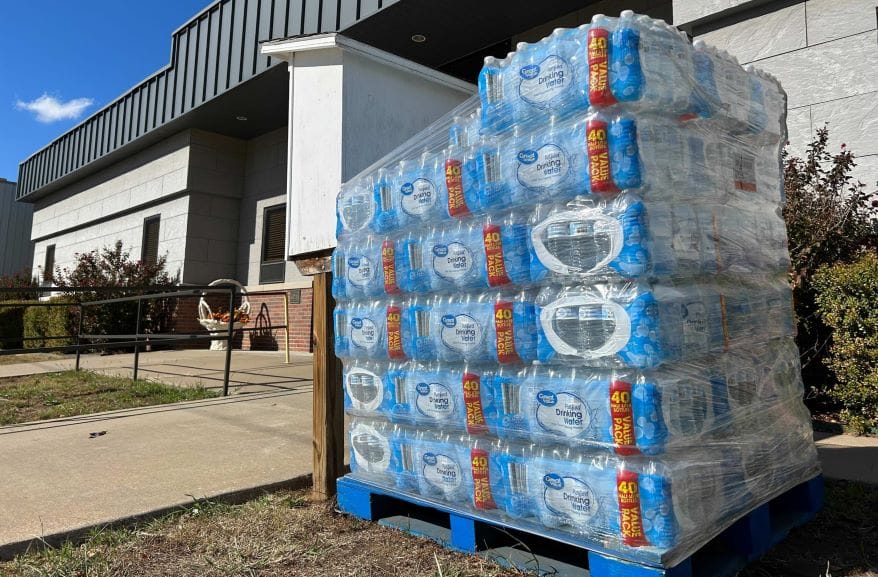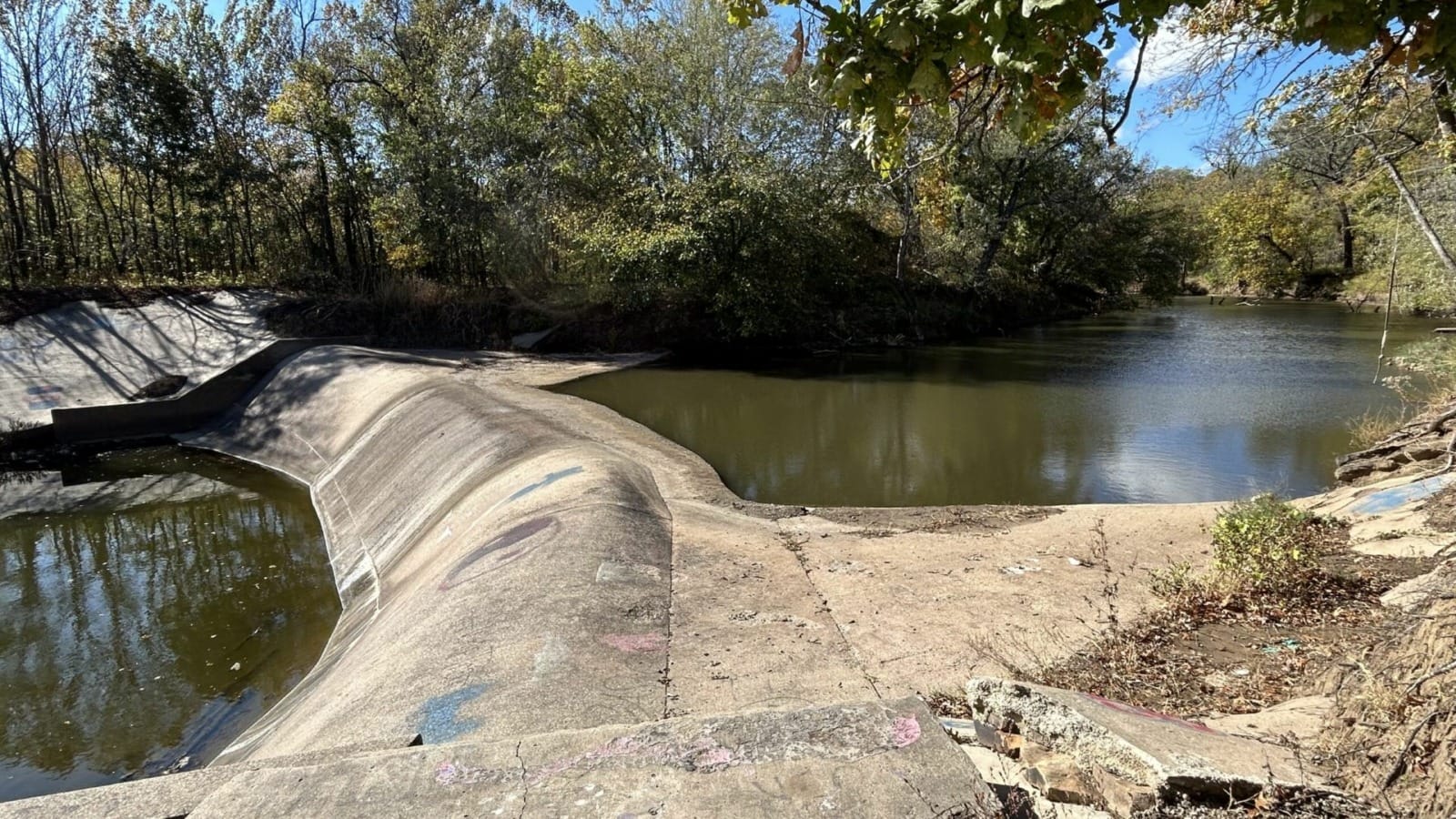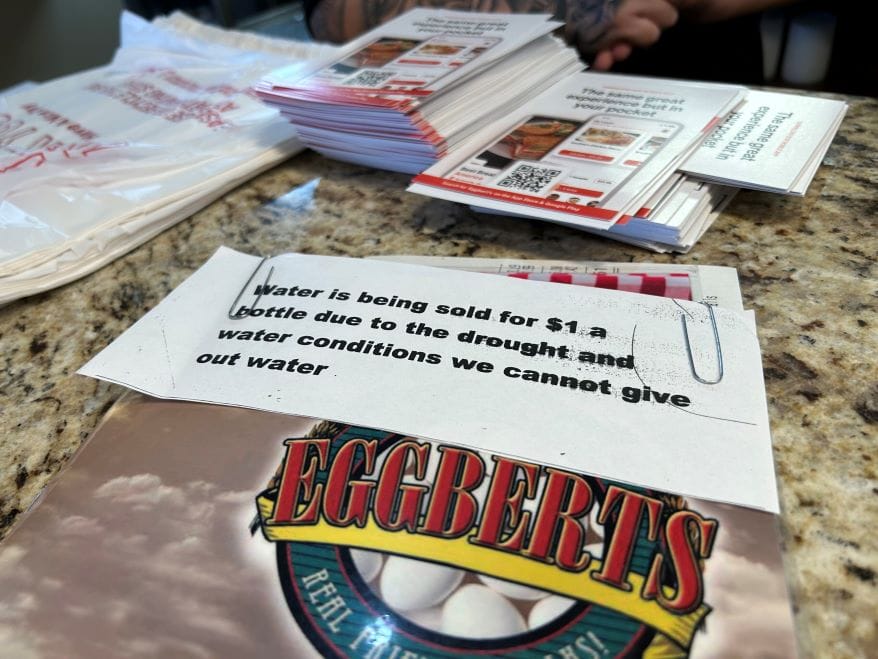Southeast Kansas Town is Almost Out of Water, and Signs of Crisis are Everywhere ‘Worst it’s been since any of us have been alive’
Published October 30th, 2023 at 1:32 PM
Above image credit: Water levels in the Little Caney River are so low that the river isn’t flowing over the dam, leaving the stream dry. (Allison Kite | Kansas Reflector)CANEY, Kansas — It’s hardly a question of whether the water will run out for one town on the Kansas-Oklahoma border. It’s a matter of when.
The stubborn drought that has hung over southeast Kansas for close to two years has brought Caney, a town of less than 2,000 people, within weeks of reaching the end of its water supply. Without rain, Caney could run dry by Christmas.
“This is the worst it’s been since any of us have been alive,” said City Manager Kelley Zellner.
Signs of the crisis are everywhere.
At Eggbert’s, a diner at the edge of town, the price of bottled water is listed with the restaurant’s specials by the front door. Menus carry a notice that the staff can’t give out tap water.
Cases of bottled water, donated by Walmart, sit in front of City Hall. There’s a portable bathroom trailer outside the junior and senior high school. And the town’s primary water source, the Little Caney River, is so low that the water that remains is stagnant.
Downstream of the town, the riverbed is dry.
Even among the drought-stricken towns in southeast Kansas — where stock water ponds are half their normal size and creek beds are completely dry — Caney’s crisis stands out. It can draw water from its backup source, Timber Hill Lake, one more time, Zellner estimates.
The town is trying desperately to conserve the water it has left. But it’s not clear what will happen when that water runs out.
Local officials are in talks with state and federal agencies, said Rick Wihitson, Montgomery County’s emergency manager
“Everyone’s trying to figure out the best solution,” Whitson said, “but we have yet to find out what that’s going to be,” Whitson said.

Ongoing Drought
Water hasn’t flowed over the dam in the Little Caney River — the point at which the town draws its drinking water — since July, Zellner said.
“We shut down the swimming pool that day,” he said.
Caney’s car wash also sits idle.
While the town has cut back, the drought persists .
At the beginning of the year, the entirety of Montgomery County was in an “extreme” or “exceptional” drought. That figure has fallen to 60% of the county, but it’s been over a year since any part of the county wasn’t in at least a mild drought.
Matthew Sittel, an assistant climatologist for Kansas, said a nearby precipitation gauge north of Havana received only half its normal rainfall since July. Another gauge in Chautauqua County got 9.2 inches of rain since July, which is 5.5 inches short of its normal.
And while much of southeast Kansas is suffering through the same drought, Caney, unlike other towns, doesn’t receive water from any of the reservoirs managed by the U.S. Army Corps of Engineers that supply other towns.
Caney is looking to long-term solutions to its water shortage. But right now, it needs to get by.

Scramble to Respond
When Carney Mayor Joshua Elliott found out earlier this month that the city could only draw water one more time, he was gravely concerned.
He wouldn’t call it a “freakout,” but he felt a responsibility to try to make the town’s water last as long as possible. He immediately ordered all public restrooms closed.
“The town kind of freaked out on that,” he said.
The city ultimately relaxed that edict, saying restrooms needed to be reserved only for businesses’ paying customers.
At the barber shop near the north end of town, a customer who didn’t want to be interviewed complained that the water wasn’t worth drinking and still more expensive than anywhere nearby.
Eggbert’s was one of the businesses that objected to the restroom closures. General Manager Kim McMahan said within hours of the order, Eggbert’s lost customers.
“If we had to leave the restrooms closed … it’s going to cause businesses in this town to shut down,” McMahan said.
Most of Eggbert’s customers are elderly. Some wouldn’t be able to get in and out of a portable toilet with their walkers, McMahan said.
“Nobody’s going to want to come in and eat if you can’t wash your hands, can’t use the restroom,” she said.
Eggbert’s is trying to do its part. It has stopped giving out tap water. It charges $1 for bottled water. As McMahan starts to explain how customers have taken the news that the restaurant won’t give them free water, a server on her staff walks by.
“People are mad,” she said as she walked away with plates.
“Very,” McMahan said, chuckling.
Some people have understood, she said. Others were indignant.
“Some will not spend a dollar on water and turn around and buy a $3 soda,” she said. “It’s not my money, so it’s whatever you want to do.”

Starting Monday, Caney schools will move to a four-day week to help conserve water.
The district, Caney Valley Public Schools, announced that it would cancel several class days between now and the students’ winter break to help ease the demand for water. The schools are among the largest water users in town.
And last week, the Montgomery County Commission declared a state of emergency, citing the “extreme measures” the town had to impose to deal with the drought.
Jane Welch, a spokeswoman for the Kansas Department of Emergency Management, said in an email that the state agency had been in contact with the city about the crisis and that the city indicated there “is not an immediate concern of the city being without potable water in their public water supply.”
It isn’t the first time that state emergency managers have been called in to deal with a water shortage in Caney, she said.
The Kansas Department of Health and Environment did not answer questions about the crisis.
Allison Kite is a data reporter for the Kansas Reflector, where this story first appeared, with a focus on the environment and agriculture.


